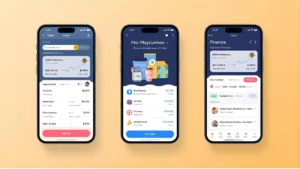In the United States, a credit score is more than just a number: it is a password to financial life. It determines the interest rate on a loan, the approval of a credit card, and even the cost of car insurance. For the generation that is still building its history, any misstep can be costly. And the misstep of the moment has a name and address: the resumption of student loan payments.
After nearly five years of pause during the pandemic, payments once again became mandatory in 2023. The regularization seemed gradual, but in February 2024, late payments officially began being reported to credit bureaus. The result was immediate: millions of young Americans saw their FICO scores decline, some with drops of more than 50 points from one month to the next.
According to FICO, about 14% of young adults between the ages of 18 and 29 lost 50 points or more on their scores in just the first quarter. That is nearly double what was seen in 2021. Among these young people, many already report difficulty obtaining credit under favorable conditions. For those just starting their financial lives, student loan delinquency has become a new stress test.
Why is the effect more severe among young people?
The logic is simple: the shorter the credit history, the more volatile it is. The FICO score takes into account factors such as length of relationship with banks, variety of accounts opened, and, most importantly, payment history. For young people with only a few years of records and often just one credit card and student loans, a missed payment weighs proportionally more.
In addition, student loans have a feature that amplifies the problem. What appears to be a single monthly payment is actually often spread across several “sub-loans.” When nothing is paid, all of those items are reported as delinquent, multiplying the negative impact on the credit report.
A new student loan delinquency can drop a credit score by more than 150 points, according to the Federal Reserve Bank of New York. Paradoxically, those with higher scores tend to lose more points precisely because they have more “altitude” to fall.
Default: the looming ghost
Student loan servicers usually classify a payment as “late” after 90 days. But if nonpayment continues for about nine months, the loan is considered in default — formal delinquency. At this stage, the government can trigger severe collection measures, including withholding tax refunds, garnishing wages, and even freezing bank accounts. In May 2024, the Department of Education resumed this type of compulsory collection.
Between February and April, more than six million consumers already had a delinquency reported in their records. For them, the average score fell from 617 to 548 in just three months — a plunge that transforms “fair” credit into what is considered “poor.”
How to escape the trap?
The good news is that there are alternatives before default. Students can request a deferment or a forbearance, even retroactively, to bring their account current and prevent new negative records. This move does not erase already reported late payments but stops the ongoing decline.
Another option is to switch to income-driven repayment plans (IDRs), which reduce the installment amount based on salary and family size. The logic is that an affordable payment increases the chances of staying current, and consistency is the most valuable currency for a score.
If default has already occurred, there are two paths: rehabilitation, which requires nine affordable payments over 10 months and, at the end, removes the default mark from the history; or consolidation, which turns balances into a new loan but keeps negative records in the report.
The difference between the two lies in the scar: in rehabilitation, the default mark disappears, though previous late payments remain. In consolidation, both the late payments and the default remain.
Time as an ally
Negative information remains on the report for up to seven years, but that does not mean the score will remain low for that entire time. The statistical weight of a late payment diminishes as it recedes into the past. Credit specialists remind us that, with discipline, it is possible to see significant recovery in 12 to 24 months.
Rebuilding depends basically on two pillars: making payments on time and controlled use of credit. Payment history accounts for about 35% of the score, while credit utilization — how much of the limit you use — represents another 30%. Keeping usage below 30% already helps, and below 10% accelerates recovery.
The temptation of shortcuts and common mistakes
Faced with a sharp drop, many young people look for shortcuts to “fix” their score. But opening several credit cards at once, for example, can have the opposite effect: each new account reduces the average age of credit history, and each application generates an inquiry that negatively impacts the short term.
Another mistake is committing to installments larger than the budget allows, in the hope of paying off the debt faster. The scoring system does not reward promises, but consistency. A smaller, manageable plan is worth more than a heroic attempt that fails after a few months.
The role of rent and utilities
In recent years, services have emerged that allow reporting of on-time rent payments to credit bureaus. They can help those with little history improve their score, but experts recommend caution. It is essential to ensure that only on-time payments are reported, and not late ones — otherwise, the risk outweighs the benefit.
The same applies to utility services, such as electricity, water, and internet. Most only appear on the report in cases of severe delinquency, when the account is sent to external collection. There are companies that offer positive utility reporting, but the gain is usually modest and depends on the existing credit profile.
Comparison: late payments vs. default
To understand the practical difference between late payments and default, see the table below:
| Situation | Time without payment | Impact on score | Record on report | Direct consequences |
| Reported late payment | 30 to 90 days | Moderate to severe drop (up to 100 points) | Remains for up to 7 years | Makes immediate credit harder, but still reversible |
| Default | About 9 months | Severe drop (up to 150 points or more) | Formal delinquency mark + late payments | Compulsory collections, tax refund withholding, wage garnishment |
The horizon of rebuilding
Despite the worrying scenario, the path to recovery is realistic. Credit experts estimate that, with on-time payments and responsible use, a young person can regain much of the lost credibility within two years. The secret is to see the score not as punishment but as a moving portrait — a statistical reflection of financial discipline.
In practice, each month of correct payment is another vote of confidence recounted to the market. Each controlled bill, each reduced balance, each honored installment reduces the weight of past stains.
Credit, in the end, is less about perfection and more about predictability. And if Generation Z has learned anything from this process, it is that the math of credit reports can be relentless in the short term, but rewarding for those who play the long game.








